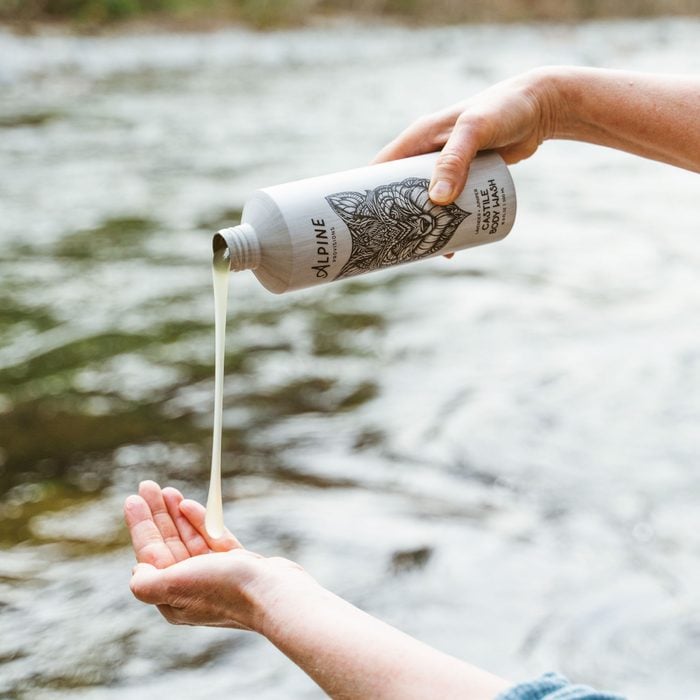Homeowner’s Guide To Castile Soap

From faces to floors, here's how and why to use naturally non-toxic and biodegradable Castile soap.
Our editors and experts handpick every product we feature. We may earn a commission from your purchases.
In the 1950s corporations embraced the chemical revolution, formulating many of the big brand-name cleaning products we still use today. Also around then a German immigrant named Emanuel Bronner, whose parents died in Nazi concentration camps, chose a different path. He gave away chemical-free soap to anyone willing to listen to his ideals of peace and unity.
He innovated natural cleaners, and his brand — Dr. Bronner’s — became synonymous with Castile soap. (Bronner wasn’t actually a doctor.) Today, as we become more aware of the personal and environmental hazards of synthetic chemicals, other Castile makers have entered the marketplace.
“Castile soap contains no toxins, endocrine or immune disruptors, and is all-around better for our bodies and the planet,” says Joshua Onysko, a friend of the Bronner family and founder of Alpine Provisions and Pangea Organics. “It’s biodegradable, and if it’s made properly, it’s also much gentler on the skin.”
On This Page
What Is Castile Soap?
Castile soap originated in the Castile region of Spain more than 500 years ago. Today, Onysko says the term Castile usually means “natural soap.” It is most often sold as a liquid but also available in bars.
Castile is a true soap, unlike most of what we call soap today, which is actually detergent. The difference between detergent and soap? Detergents are made from synthetic chemicals which aren’t biodegradable. “It actually should be illegal for people to call detergent `soap’ because it’s not soap,” says Onysko.
What Is Castile Soap Made Of?
While Spanish Castile soap was originally made from olive oil, today’s Castiles feature plant-based ingredients like coconut, jojoba, hemp and essential oils. Those fats are then combined with lye, an alkali. This process of turning ingredients into soap is called saponification.
How To Use Castile Soap
Castile soap is good for personal hygiene as well as home cleaning. Liquid Castile soap comes concentrated, so you’ll need to dilute it for most applications. Common uses include:
- Face and body;
- Dishes;
- Laundry (machine and hand-wash);
- Floors;
- Toilets;
- Pets.
Because it’s biodegradable, Castile soap is also good for camping. Just make sure you’re at least 200 feet from lakes and rivers. “People wrongly think that just because it’s natural, they can bathe with it in lakes and rivers,” says Onysko. “But that’s like squirting soap into your fish tank.”
Some people also wash their hair with Castile soap, but Onysko recommends against that. “It’s also not good to brush your teeth with, even though some people think they can,” he says.
How To Make Castile Soap
It’s possible to make Castile soap at home, but it’s a long, complex process that requires handling dangerous potassium hydroxide lye. So unless you already have soap-making experience, it’s better to buy than DIY.
Cleaners To Make with Castile Soap
Dr. Bronner’s recommends Castile soap in various green and DIY cleaning applications, alongside other natural products like vinegar, lemons and baking soda. A few cleaner ideas include:
- All-purpose cleaning spray: Mix 1/4-cup soap, one quart water and 1/4-teaspoon tea tree essential oil in a spray bottle.
- Window cleaner: Mix one tablespoon soap with a quart of water in a spray bottle. Spray and squeegee, then spray club soda or a 50-50 mix of water and vinegar. Then squeegee again.
- Anti-bug plant spray: If you have an infestation, mix one tablespoon soap with one quart water and 1/2-teaspoon cayenne pepper or cinnamon. Spray plants twice a day. (It’s best to do this in the morning, when it’s cool.)
- Wipe-off body spray: If you have a medical cast or bandage, or find yourself anywhere without running water, combine 1-1/2-teaspoons soap with a cup of water in a spray bottle. Lightly spray your skin, then wipe with a wet cloth
Environmental Benefits of Castile Soap
Concentrated liquid Castile soaps are biodegradable and free of synthetic chemicals. Also, companies that make Castile soap tend to be kind to the planet and humans in other ways. Many use organic, sustainably sourced, fair-trade, vegan ingredients.
Best Castile Soaps To Buy
Dr. Bronner’s Castile Soap is the top-selling brand in North America. It’s certified organic, fair trade, vegan and cruelty-free. Try its iconic, original peppermint scent or one of the many other options.
Alpine Provisions Body Wash contains sustainably sourced ingredients and comes in aluminum packaging. Its most popular scents are fir-and-sage and cedar sandalwood.
Carolina Castile Soap is particularly gentle on sensitive skin because it contains moisturizing olive and coconut oil. It’s also certified organic and vegan, made in the U.S. and comes in a large array of scents.



